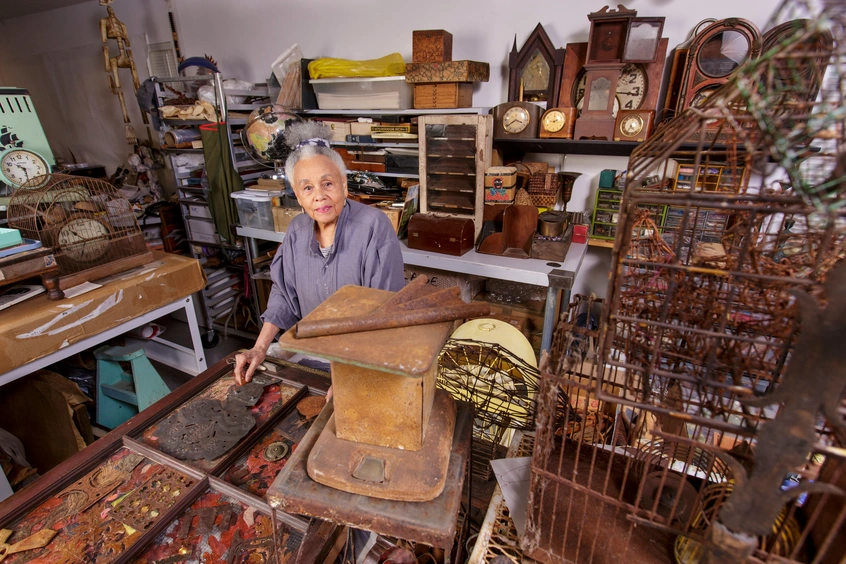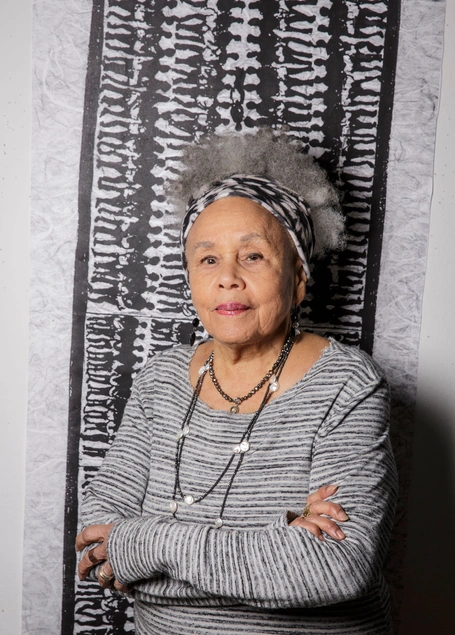SAN MARINO, Calif.—The Huntington Library, Art Museum, and Botanical Gardens announced today that it has commissioned artist Betye Saar to create a large-scale, immersive installation for the Virginia Steele Scott Galleries of American Art. Provisionally titled Drifting Toward Twilight, the site-specific work will feature a 17-foot-long wooden canoe that incorporates found objects, paint, neon, natural materials, and plant matter harvested by Saar from the Huntington grounds. The installation will open on Nov. 11, 2023, and will remain on view for two years, becoming a permanent part of The Huntington’s American art collection. The project is co-curated by Yinshi Lerman-Tan, Bradford and Christine Mishler Associate Curator of American Art, and Sóla Agustsson, Saar’s granddaughter and the Huntington Art Museum’s special programs and digitization assistant.
“Through this immersive installation, visitors will gain a sense of Saar’s major role in 20th-century art history, aesthetics, and culture, as well as her chosen medium of assemblage art,” said Christina Nielsen, Hannah and Russel Kully Director of the Art Museum. “Saar’s perspective as a Black feminist artist from Los Angeles and an icon of American art will be a pioneering intervention in our galleries.” The acquisition builds on significant existing works of African American art in The Huntington’s collection—including paintings and sculpture by Robert Duncanson, Sargent Claude Johnson, Charles White, and Kehinde Wiley—as well as exhibitions centering African American art history, including “Gee’s Bend: Shared Legacy.” The new commission will be the second work by Saar to join The Huntington’s collection; the first is a scarf collage titled The Fragility of Illusion (1981) that was acquired in 2015.
To complement the commission, The Huntington is producing a short film, directed by Kyle Reingold, program director of Ghetto Film School LA. Documenting footage of Saar speaking about the work in progress and the selection of natural materials with The Huntington’s botanical curators, the film will also include an interview with Agustsson covering Saar’s life and work. An accompanying publication for the project will add a new lens to scholarship about Saar, focusing on her early life and inspiration in Pasadena (where she grew up), including an oral history of Saar’s childhood memories of The Huntington and the surrounding area. The publication will include contributions from co-curators Lerman-Tan and Agustsson; Tiffany E. Barber, assistant professor of African American art at UCLA; Ishmael Scott Reed, an American poet, novelist, playwright, and longtime friend of Saar; and a foreword by Nielsen.
“When I was a child in the 1930s, I would come to The Huntington with my mother and aunt, who were avid gardeners. As I became an artist, I realized the importance, and the influence, of nature in my work—whether it’s the moon and the stars, branches and rocks, or bones and shells,” Saar said. “It is my desire that Drifting Toward Twilight brings the outside in, blending the gardens with the gallery and creating an immersive, contemplative experience for the viewer.”
Betye Saar (b. 1926) is one of the most significant living American artists. Over her six-decade career, Saar has created assemblage works exploring themes of racial oppression, mysticism, the occult, family, memory, and identity. She fashions her assemblage artworks from found objects, antiques, and family heirlooms that she collects. Emerging as an important artistic voice during the feminist and civil rights movements, Saar is a pioneer of Black feminist art who connected the personal with the political, taking on such subject matter as the legacies of enslavement and the impacts of racism.
Born in Los Angeles, Saar moved with her family in the early 1930s to a north Pasadena neighborhood, where Jackie Robinson was her neighbor. She attended Pasadena City College and went on to teach at the now-shuttered Pasadena Film School. Saar was a key figure in the art communities of Pasadena and greater Los Angeles in the late 1950s, communing with a burgeoning group of Black artists whose works shaped the history of art today. In 1967, she experienced a formative artistic influence at the Pasadena Art Museum (now the Norton Simon Museum), where the assemblages of American artist Joseph Cornell inspired her. Saar’s oeuvre since the late 1960s has deployed iconography related to African American history and experience.
###
[EDITOR’S NOTE: High-resolution digital images available for publicity use. Request Images]
About The Huntington
The Huntington Library, Art Museum, and Botanical Gardens is a cultural and educational institution of global significance. Building on Henry E. and Arabella Huntington’s renowned collections, The Huntington supports research and promotes education in the arts, humanities, and botanical science through the growth and preservation of its collections; the development of a community of scholars, school programs, and partnerships; and the display and interpretation of its extraordinary resources for diverse audiences. The Huntington is located at 1151 Oxford Road, San Marino, California, 12 miles from downtown Los Angeles. Visitor information: huntington.org.
Contacts
Thea M. Page, 626-405-2260, tpage@huntington.org
Jessica McCormack, 323-497-9308, huntingtonnews@huntington.org

